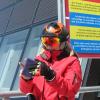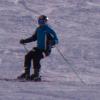

ROTATIONAL BALANCE
A ski racing turn is essentially a rotation around a gate. This rotation has forces which need to be dealt with to control balance (or stay in equilibrium). If the rotation of the skis is left unchecked by the skier's upper body, the skier will essentially rotate themselves out of balance. There needs to be a force to counter the skis rotation around the gate.
Rotational concerns are easiest to comprehend or visualize in pivoted short, quick turns. In these turns, the rotational impetus creating the turn is much more dramatic. Even when these short turns are carved there is a rotational component. Putting the ski on edge involves a rotation of the femur within the pelvis. Looking at these two bones in reverse, you would see the pelvis rotating on top of the femur. Sir Isaac Newton would explain it by noting the upper body rotates with the same force as the lower body but in the opposite direction. This is what we see with good ski racers. Their upper body looks quiet in space. However, the upper body is actually rotating opposite the lower body. This occurs in all turns but is most dramatic in shorter, quicker turns. In long radius turns, the legs rotate at a much slower pace and therefore the upper body rotates at that exact slower pace as well.
Rotational Impetus: The force, torque, or energy needed or used to initiate a revolution.
Newton's Third Law: "Forces come in Pairs" "If one object pushes on another, then the second object pushes back on the first with a force of the same strength"

Сообщение отредактировал Maykl: 06 October 2020 - 03:45

![]()
















